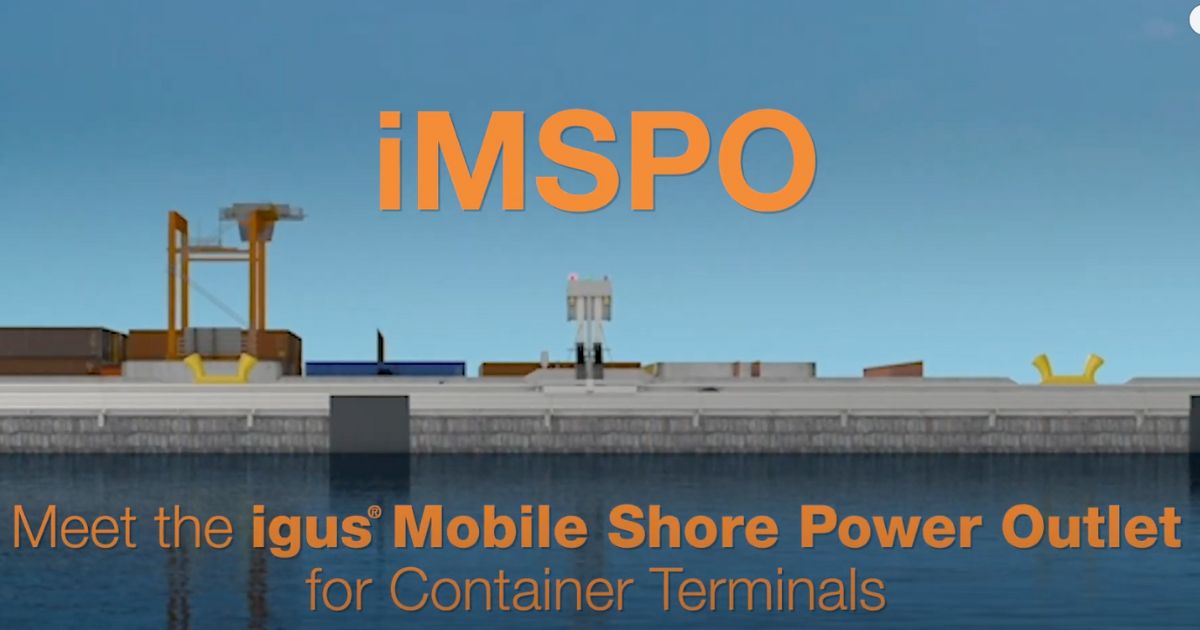igus will present its revolutionary mobile shore power technology, the readychain® iMSPO, at the Ports ‘22 conference in Hawaii in September.
igus, based in Germany, runs its North American operations out of Providence, R.I. The readychain® iMSPO, which is going to be installed in European ports as a self-propelled socket for the shore power connection of container strips, is now available in the United States.
Ports are critical to jobs, competitiveness and economic prosperity for the United States. When in port, vessels such as cruise ships, container ships, and reefer ships have significant energy needs. Today, this energy is typically generated by ships’ auxiliary diesel engines. Emissions from ships at berth contribute significantly to air pollution and cause health problems for local residents.
Based on its core competence in the field of energy supply systems with energy chains, igus has developed a movable socket that travels along the quay over hundreds of meters precisely to the respective connection position of the ship.
Reducing emissions
Like all industries, ports are facing the major challenge of reducing pollutant emissions and ultimately becoming climate-neutral. When ships at berth obtain their electricity with diesel generators, the demand is immense, similar to that of a small town. The generators also emit CO2, as well fine dust and nitrogen and sulfur oxides.
Shore power can be used by ships to connect to the local power grid. Auxiliary engines can then be switched off while in port. This allows power for lighting or air conditioning or other electronic equipment on board for the crew to draw from the local power grid. Shore power thus serves to reduce emissions from auxiliary engines at berth.
The advantage of shore power technology is that there is an internationally recognized standard and pilot systems that are already operating successfully. However, as with any new infrastructure, there are great challenges to be faced, whereby encouragement is needed and someone to lead the way.
Port of Hamburg takes first step
California was the first in the world to implement shore power. Now, five major European ports - Hamburg, Bremerhaven, Rotterdam, Antwerp and Le Havre - have jointly agreed to supply their container ships of 14,000 TEU or more with shoreside electricity by 2028. In the U.S., the ports of San Diego and Miami are investing millions of dollars in the new shore power technology, also known as cold ironing.
The Port of Hamburg has decided to take the first step and install the world's first mobile connection systems for container ships. In addition to the technical challenges of power supply, such as the right voltage and frequency, another problem must be solved for the future-proof operation of a shore power system - the connection dilemma.
A container terminal is a carefully timed operation with constantly changing ships of different sizes and berthing positions. This means that the connection points vary continually – there is no fixed place where the vessel can be "plugged in.” The Port of Hamburg therefore relies on the movable connection systems from igus.
Flexible systems solve the connection dilemma
Every port is unique: tidal behavior, terminal design and equipment differ from port to port. Container ships equipped for shore power carry a cable reel on board that makes it possible to lower two cables with connectors down onto the quay. These can then be connected to appropriate couplings on the quay.
However, the cable reel may be installed at different positions on the ship. Ships can dock at the quay at either the port or starboard side. Vessels also vary considerably in size. This means that no fixed connection point will be right for all situations..
The iMSPO (igus Mobile Shore Power Outlet) system is a solution to this connection problem: The combination of igus roller energy chain and special chainflex® medium-voltage cables enables the system to travel within a range of up to 400 meters (which corresponds to the length of the largest container ships).
Due to the small bending radii of the chainflex® cables, the system can be designed compactly and mounted in a space-saving manner. Thus, shore power availability is provided over the entire berth. The movable socket is moved along the quay, exactly to the point where the ship's connection point is located. The ship cables only have to be lowered and connected to the movable socket. The iMSPO is operated with a remote control.
The knowledge gained through interaction with customers and the company's own experience from successfully installed shore power systems for ferries, FSUs (floating storage units), OSVs (offshore supply vessels) and the largest working vessels in Rotterdam were incorporated into the development.
The possibility of testing the system's functionality in igus' test laboratory, which is the largest in the industry, was a decisive factor in the decision. "Being able to be a part of this project is a great honor for us," said Martin Tiling, Shore Power industry manager at igus. "We are proud to be part of a new green innovation and are confident that our ideas and technologies will continue to contribute to a more climate-friendly future."
Ports ’22 will be held in Honolulu, Hawaii from September 18-21. The conference advances the art and science of port engineering and improving the maritime world.


